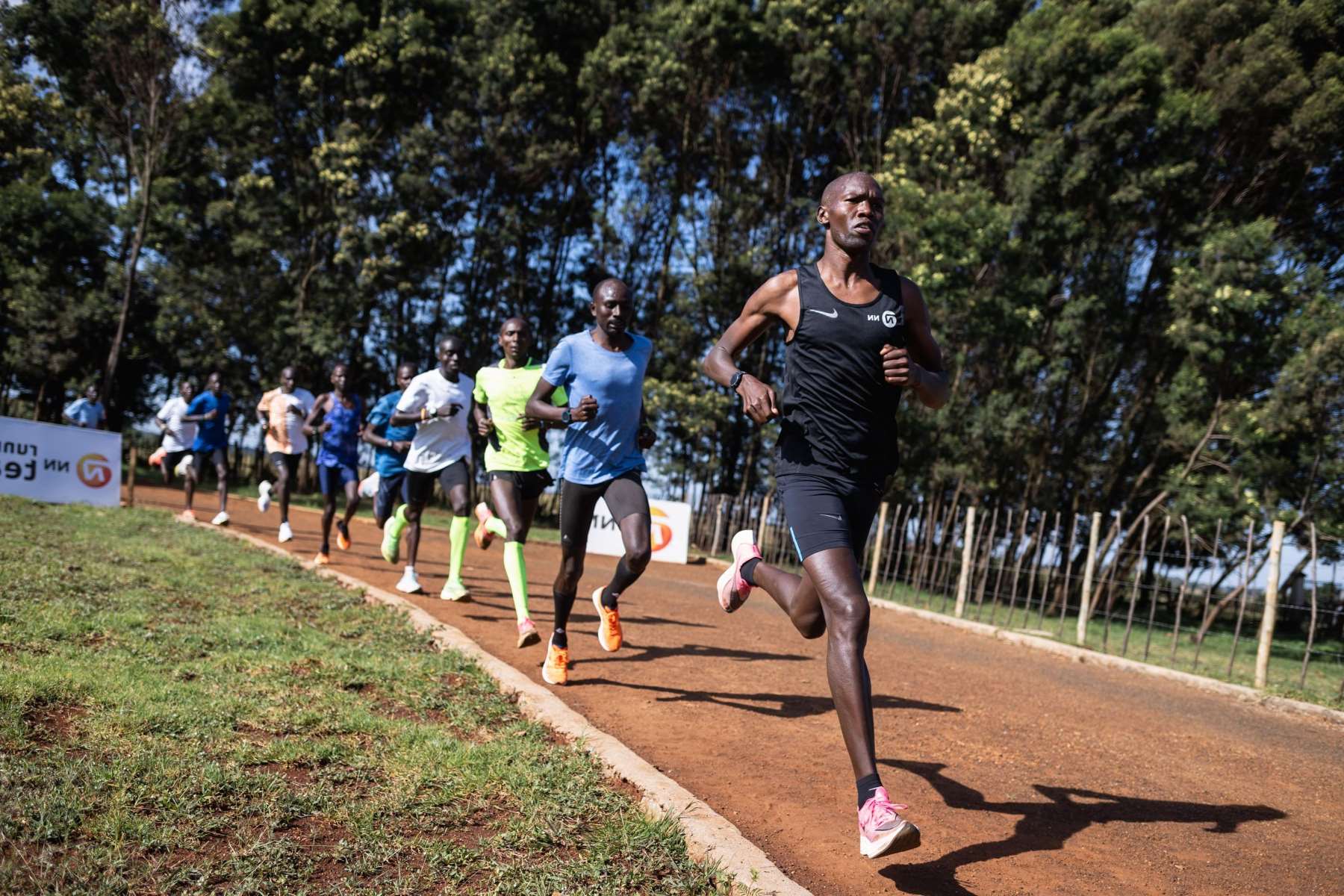Home>Training & Techniques>Comparing Running By Time To Running By Distance


Training & Techniques
Comparing Running By Time To Running By Distance
Published: March 3, 2024
Learn the best training and techniques for comparing running by time to running by distance. Improve your running performance with expert tips.
(Many of the links in this article redirect to a specific reviewed product. Your purchase of these products through affiliate links helps to generate commission for Therunningadvisor.com, at no extra cost. Learn more)
Table of Contents
Introduction
When it comes to running, there are various approaches that individuals can adopt to structure their training sessions. Two popular methods for organizing running workouts are running by time and running by distance. Each approach has its own set of advantages and considerations, and the choice between the two often depends on the runner's specific goals, preferences, and physical condition.
In this article, we will delve into the intricacies of these two methods, exploring the nuances of running by time and running by distance. By examining the benefits and drawbacks of each approach, we aim to provide runners with valuable insights to help them make informed decisions about their training regimen. Whether you are a seasoned runner seeking to optimize your workouts or a novice looking to embark on a fitness journey, understanding the differences between these two methods can significantly impact the effectiveness and enjoyment of your running experience.
As we navigate through the details of running by time and running by distance, it's important to recognize that there is no one-size-fits-all solution. Every runner is unique, and what works best for one individual may not necessarily be the ideal approach for another. By shedding light on the distinct characteristics of these methods, we aim to empower runners to make personalized choices that align with their fitness objectives and personal preferences.
So, whether you prefer the structured discipline of running for a set duration or the tangible milestones of covering specific distances, this exploration of running methodologies aims to equip you with the knowledge to make informed decisions about your training approach. Let's embark on this journey to unravel the intricacies of running by time and running by distance, and discover which method may best suit your running aspirations.
Read more: What Is Your Running Distance Limit?
Understanding Running by Time
Running by time is a training approach that focuses on the duration of the workout rather than the distance covered. This method involves setting a specific time frame for a running session, such as 30 minutes or one hour, and exerting effort within that period. By adhering to a predetermined time limit, runners can effectively structure their workouts and gauge their progress based on the duration of their runs.
One of the key advantages of running by time is its flexibility. This approach allows runners to adapt their training sessions to accommodate varying fitness levels, terrain challenges, and environmental factors. For instance, a runner may allocate 45 minutes for a training session and adjust their pace and intensity based on factors such as weather conditions, fatigue, or terrain difficulty. This adaptability enables individuals to maintain consistent training routines while accommodating the unpredictability of outdoor running environments.
Moreover, running by time can be particularly beneficial for beginners or individuals returning to running after a hiatus. By focusing on the duration of the workout, rather than the distance covered, novice runners can gradually build their endurance and stamina without feeling pressured to achieve specific mileage targets. This approach promotes a gradual progression, allowing individuals to acclimate to the physical demands of running while minimizing the risk of overexertion or injury.
Additionally, running by time can be a valuable tool for incorporating interval training and varied intensities into a workout. By segmenting the running session into intervals of different durations, runners can engage in high-intensity efforts followed by periods of active recovery. This structured approach to interval training can enhance cardiovascular fitness, improve speed, and boost overall performance.
However, it's important to note that running by time may present challenges in accurately measuring the intensity and effort exerted during a workout. Unlike running by distance, where the tangible distance covered serves as a clear indicator of progress, running by time relies on subjective perceptions of effort and intensity. As a result, runners may find it challenging to track and compare their performance over time, potentially leading to ambiguity in assessing progress and setting realistic goals.
In essence, understanding the nuances of running by time provides valuable insights into the flexibility, adaptability, and structured training opportunities that this method offers. By recognizing the benefits and considerations associated with running by time, runners can make informed decisions about incorporating this approach into their training regimen.
Understanding Running by Distance
Running by distance is a training approach that revolves around covering specific distances during running sessions, prioritizing the mileage achieved over a predetermined route or course. This method provides runners with tangible benchmarks and measurable targets, allowing them to track their progress and set clear objectives based on the distances covered.
One of the primary advantages of running by distance is the concrete sense of accomplishment it offers. By setting distance-based goals, runners can experience a profound sense of achievement upon reaching and surpassing their intended mileage. Whether it's conquering a new personal best or completing a challenging race distance, the quantifiable nature of running by distance can instill a deep sense of satisfaction and motivation, propelling individuals to strive for continuous improvement.
Moreover, running by distance fosters a structured and goal-oriented approach to training. By delineating specific distances to be covered within a given timeframe, runners can establish clear training objectives and tailor their workouts to align with their performance targets. This method enables individuals to systematically progress from shorter distances to more ambitious goals, fostering a sense of purpose and direction in their running endeavors.
Additionally, running by distance provides a reliable means of tracking performance and gauging improvements over time. By consistently logging the distances covered in each running session, individuals can monitor their progress, identify trends in their performance, and make informed adjustments to their training regimen. This data-driven approach empowers runners to set realistic and attainable goals, leveraging their past achievements as a benchmark for future endeavors.
However, it's important to recognize that running by distance may pose challenges in adapting to variable conditions and unforeseen obstacles. Unlike running by time, which offers flexibility in adjusting the workout duration based on external factors, running by distance requires a steadfast commitment to completing the designated mileage, regardless of environmental conditions or physical fatigue. This rigidity may present challenges in maintaining consistency and adapting to dynamic running environments.
In essence, understanding the dynamics of running by distance sheds light on the structured, goal-oriented, and measurable aspects that define this training approach. By acknowledging the benefits and considerations associated with running by distance, runners can make informed decisions about integrating this method into their training routine, leveraging its potential to drive progress and foster a sense of achievement in their running pursuits.
Pros and Cons of Running by Time
Running by time offers a range of benefits and considerations that can significantly impact a runner's training experience. By understanding the advantages and potential drawbacks of this approach, individuals can make informed decisions about incorporating running by time into their workout regimen.
Pros
-
Flexibility and Adaptability: Running by time provides a flexible framework for training sessions, allowing runners to adjust their pace and intensity based on varying factors such as weather conditions, terrain challenges, and personal fatigue. This adaptability enables individuals to maintain consistent training routines while accommodating the unpredictability of outdoor running environments.
-
Gradual Progression for Beginners: For novice runners or those returning to running after a hiatus, focusing on the duration of the workout rather than the distance covered can facilitate a gradual progression. This approach allows individuals to build endurance and stamina at a comfortable pace, reducing the risk of overexertion or injury often associated with targeting specific mileage goals.
-
Interval Training Opportunities: Running by time facilitates the incorporation of interval training, where runners can segment their sessions into intervals of different durations. This structured approach to interval training can enhance cardiovascular fitness, improve speed, and boost overall performance, offering a valuable tool for diversifying training routines.
Cons
-
Subjective Measurement of Effort: Unlike running by distance, where the tangible distance covered serves as a clear indicator of progress, running by time relies on subjective perceptions of effort and intensity. This subjective nature may make it challenging for runners to accurately measure and compare their performance over time, potentially leading to ambiguity in assessing progress and setting realistic goals.
-
Difficulty in Tracking Progress: The absence of tangible distance markers in running by time may pose challenges in tracking progress and setting measurable benchmarks. Without clear distance-based goals, individuals may find it challenging to gauge their improvements and may struggle to establish concrete performance targets.
In essence, the flexibility and adaptability of running by time make it an appealing option for individuals seeking a versatile training approach. However, the subjective nature of effort measurement and the potential difficulty in tracking progress underscore the need for careful consideration when integrating running by time into a training regimen. By weighing these pros and cons, runners can make informed decisions that align with their fitness goals and preferences.
Pros and Cons of Running by Distance
Running by distance offers a structured and goal-oriented approach to training, presenting runners with tangible benchmarks and measurable targets. By understanding the advantages and potential drawbacks of this method, individuals can make informed decisions about incorporating running by distance into their workout regimen.
Pros
-
Concrete Sense of Accomplishment: One of the primary advantages of running by distance is the tangible sense of achievement it provides. Setting distance-based goals allows runners to experience a profound sense of accomplishment upon reaching and surpassing their intended mileage. Whether it's conquering a new personal best or completing a challenging race distance, the quantifiable nature of running by distance can instill a deep sense of satisfaction and motivation, propelling individuals to strive for continuous improvement.
-
Structured Training Objectives: Running by distance fosters a structured and goal-oriented approach to training. By delineating specific distances to be covered within a given timeframe, runners can establish clear training objectives and tailor their workouts to align with their performance targets. This method enables individuals to systematically progress from shorter distances to more ambitious goals, fostering a sense of purpose and direction in their running endeavors.
-
Measurable Performance Tracking: Running by distance provides a reliable means of tracking performance and gauging improvements over time. By consistently logging the distances covered in each running session, individuals can monitor their progress, identify trends in their performance, and make informed adjustments to their training regimen. This data-driven approach empowers runners to set realistic and attainable goals, leveraging their past achievements as a benchmark for future endeavors.
Cons
-
Rigidity in Adapting to Variable Conditions: Unlike running by time, which offers flexibility in adjusting the workout duration based on external factors, running by distance requires a steadfast commitment to completing the designated mileage, regardless of environmental conditions or physical fatigue. This rigidity may pose challenges in maintaining consistency and adapting to dynamic running environments, potentially leading to undue strain or diminished enjoyment during workouts.
-
Potential Difficulty in Adjusting to Unforeseen Obstacles: Running by distance may present challenges in adapting to variable conditions and unforeseen obstacles. While the structured nature of distance-based goals provides a sense of direction, it may also lead to frustration or disappointment when external factors, such as inclement weather or unexpected physical fatigue, impede the ability to achieve predetermined mileage targets.
In essence, the structured and measurable nature of running by distance makes it an appealing option for individuals seeking clear benchmarks and tangible accomplishments in their running pursuits. However, the potential rigidity in adapting to variable conditions and the challenges associated with unforeseen obstacles underscore the need for careful consideration when integrating running by distance into a training regimen. By weighing these pros and cons, runners can make informed decisions that align with their fitness goals and preferences.
Which Method is Best for You?
When determining the most suitable method for your running endeavors, it's essential to consider various factors that align with your fitness goals, personal preferences, and physical condition. Both running by time and running by distance offer distinct advantages and considerations, and the ideal approach hinges on individual needs and aspirations.
If you prioritize flexibility and adaptability in your training routine, running by time may be the optimal choice. This method allows for adjustments in pace and intensity based on external factors such as weather conditions, terrain challenges, and personal fatigue. It is particularly beneficial for beginners or individuals returning to running, as it facilitates a gradual progression without the pressure of achieving specific mileage targets. Moreover, the incorporation of interval training opportunities can enhance cardiovascular fitness and overall performance, making running by time an appealing option for those seeking versatile and dynamic workouts.
On the other hand, if you thrive on structured goals and tangible accomplishments, running by distance may be the preferred method. Setting specific mileage targets provides a clear sense of achievement and motivation, propelling individuals to strive for continuous improvement. This approach fosters a goal-oriented mindset, allowing runners to systematically progress from shorter distances to more ambitious goals. Additionally, the ability to track performance and gauge improvements over time through measurable distance markers empowers individuals to set realistic and attainable goals, leveraging past achievements as a benchmark for future endeavors.
Ultimately, the best method for you depends on your unique preferences, fitness objectives, and the environment in which you train. It's important to assess your individual needs and consider how each method aligns with your fitness journey. Whether you thrive on the adaptability of running by time or the structured nature of running by distance, the key is to choose a method that resonates with your aspirations and motivates you to consistently pursue your running goals.
By carefully evaluating the benefits and considerations of each approach, you can make an informed decision that harmonizes with your personal inclinations and empowers you to embark on a fulfilling and rewarding running experience.
Conclusion
In conclusion, the choice between running by time and running by distance is a pivotal decision that significantly influences the effectiveness and enjoyment of a runner's training regimen. Both methods offer distinct advantages and considerations, catering to diverse fitness goals, personal preferences, and physical capabilities. Understanding the nuances of each approach empowers individuals to make informed decisions that align with their unique aspirations and contribute to a fulfilling running experience.
The flexibility and adaptability of running by time make it an appealing option for individuals seeking versatile training routines. This method accommodates adjustments in pace and intensity, allowing runners to navigate through varying terrain challenges, weather conditions, and personal fatigue. Moreover, the incorporation of interval training opportunities enhances cardiovascular fitness and overall performance, making running by time an attractive choice for those who thrive on dynamic and diverse workouts.
On the other hand, running by distance offers a structured and goal-oriented approach, providing runners with tangible benchmarks and measurable targets. The quantifiable nature of distance-based goals instills a profound sense of accomplishment and motivation, propelling individuals to strive for continuous improvement. Additionally, the ability to track performance and gauge improvements over time through measurable distance markers empowers individuals to set realistic and attainable goals, leveraging past achievements as a benchmark for future endeavors.
Ultimately, the best method for each individual hinges on a careful consideration of personal inclinations, fitness objectives, and the training environment. Whether one resonates with the adaptability of running by time or the structured nature of running by distance, the key is to choose a method that harmonizes with one's aspirations and motivates consistent pursuit of running goals.
By recognizing the benefits and considerations of each approach, runners can embark on a fulfilling and rewarding running journey, leveraging the chosen method to optimize their training experience and achieve their fitness aspirations. Whether it's the dynamic adaptability of running by time or the structured progression of running by distance, the path to success lies in making an informed choice that resonates with individual preferences and empowers a fulfilling and sustainable running experience.














